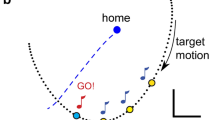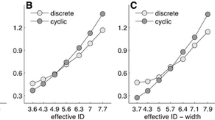Abstract
The study of speed–accuracy trade-offs has a long history in scientists’ attempts to understand human movement control. In most such studies of reciprocal aiming, participants have been required to make reaching or pointing movements in space to targets of varying size. We wished to extend this body of work to a situation in which participants had to use a steering wheel in order to move a cursor on a computer monitor. Our results revealed a positive linear relationship between movement times and movement difficulty. We also observed an increased contribution of nonlinear dynamical terms as the movement difficulty increased. These results are consistent with the claim that a linear speed–difficulty relationship is a general feature of human motor control and one which is effector-independent. These results have relevant application to the study of human driving performance.


Similar content being viewed by others
References
Accot J, Zhai S (1997) Beyond Fitts’ law: models for trajectory-based HCI tasks. In: Proceedings of ACM CHI’97 conference on human factors in computing systems, pp 295–302
Accot J, Zhai S (1999) Performance evaluation of input devices in trajectory-based tasks: an application of the steering law. In: Proceedings of ACM CHI’99 conference on human factors in computing systems, pp 466–472
Beek P, Beek W (1988) Tools for constructing dynamical models of rhythmic movement. Hum Mov Sci 7:301–342
Brookhuis K, de Vries G, de Waard D (1991) The effects of mobile telephoning on driving performance. Accid Anal Prev 23:309–316
Buchanan J, Park J-H, Ryu Y, Shea C (2004) Discrete and cyclical units of action in a mixed target pair aiming task. Exp Brain Res 150:473–489
Crossman E, Goodeve P (1983) Feedback control of hand-movement and Fitts’ law. Q J Exp Psychol 35A:251–278
Delignieres D, Nourrit D, Deschamps T, Lauriot B, Caillou N (1999) Effects of practice and task constraints on stiffness and friction functions in biological movements. Hum Mov Sci 18:769–793
Fitts P (1954) The information capacity of the human motor system in controlling the amplitude of movement. J Exp Psychol 47:381–391
Goble D, Brown S (2007) Task-dependent asymmetries in the utilization of proprioceptive feedback for goal-directed movement. Exp Brain Res 180:693–704
Guiard Y (1993) On Fitts’ and Hooke’s laws: simple harmonic movement in upper-limb cyclical aiming. Acta Psychol 82:139–159
Haigney D, Taylor R, Westerman S (2000) Concurrent mobile (cellular) phone use and driving performance: task demand characteristics and compensatory processes. Transp Res Part F: Psychol Behav 3:113–121
Horrey W, Wickens C (2006) Examining the impact of cell phone conversations on driving using meta-analytic techniques. Hum Factors 48:196–205
Mottet D, Bootsma R (1999) The dynamics of goal-directed rhythmical aiming. Biol Cybern 80:235–245
Novak K, Miller L, Houk J (2000) Kinematic properties of rapid hand movements in a knob turning task. Exp Brain Res 132:419–433
Oldfield R (1971) The assessment and analysis of handedness: the Edinburgh inventory. Neuropsychologia 9:97–113
Rashevsky N (1959) Some remarks on the mathematical aspects of automobile driving. Bull Math Biophys 21:299–308
Shannon C, Weaver W (1948) The mathematical theory of communication. University of Illinois Press, Urbana
Spence C, Ho C (2008). Crossmodal information processing in driving. In: Castro C, Hartley L (eds) Human factors of visual performance in driving. CRC Press, Boca Raton (in press)
Todor J, Cisneros J (1985) Accommodation to increased accuracy demands by the right and left hands. J Mot Behav 17:355–372
van Gemmert A, van Galen G (1988) Auditory stress effects on preparation and execution of graphical aiming: a test of the neuromotor noise concept. Acta Psychol 98:81–101
Vereijken B, Van Emmerick R, Bongaardt R, Beek W, Newell K (1997) Changing coordinative structures in complex skill acquisition. Hum Mov Sci 16:823–844
Zelaznik H, Shapiro D, McColsky D (1981) Effects of a secondary task on the accuracy of single aiming tasks. J Exp Psychol Hum Percept Perform 7:1007–1018
Zhai S, Accot J, Woltjer R (2004) Human action laws in electronic virtual worlds—an empirical study of path steering performance in VR. Presence Teleoperators Virtual Environ 13:113–127
Acknowledgment
The authors are grateful to Dr. Cristy Ho for her technical assistance in preparing this experiment.
Author information
Authors and Affiliations
Corresponding author
Rights and permissions
About this article
Cite this article
Davis, N.J., Cui, S. & Spence, C. The dynamics of reciprocal aiming with a steering wheel. Exp Brain Res 188, 141–146 (2008). https://doi.org/10.1007/s00221-008-1379-8
Received:
Accepted:
Published:
Issue Date:
DOI: https://doi.org/10.1007/s00221-008-1379-8




